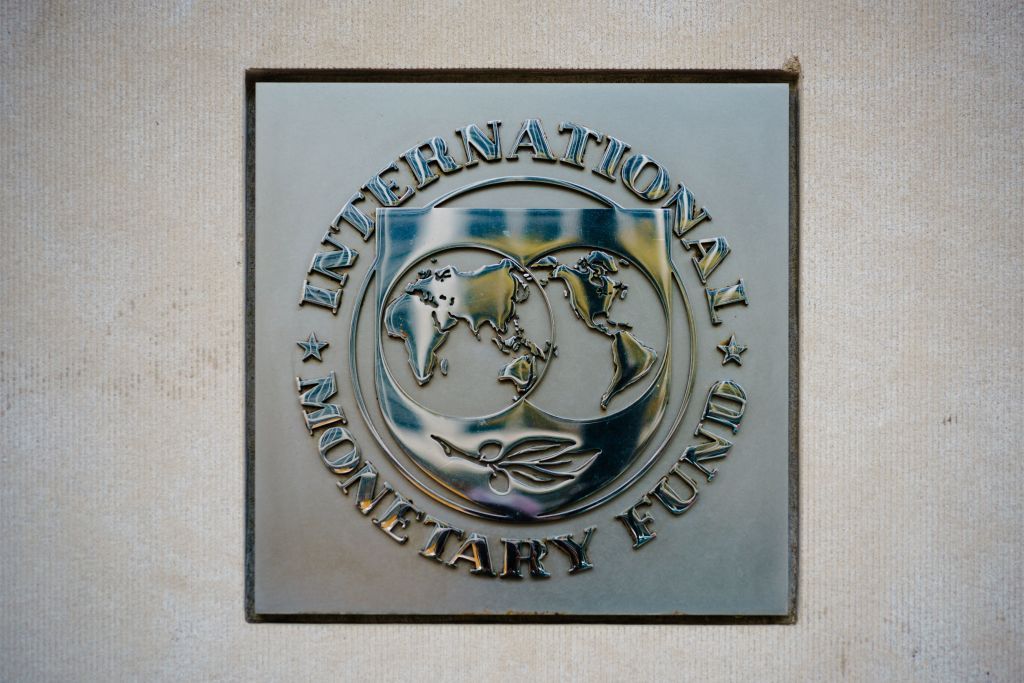
Explainer: Ukraine’s $15 billion IMF loan program
Ukrainian President Volodymyr Zelensky and International Monetary Fund (IMF) Director Kristalina Georgieva arrive to speak to the press after talks at IMF headquarters in Washington, DC, US on Dec. 11, 2023. (Roberto Schmidt / AFP via Getty Images)

Maxwell Kushnir
Maxwell Kushnir is a research analyst at the IMF. The contents of this article do not represent the views of any entity associated with the IMF, including staff, management or members of the Executive Board. Only publicly available data is used.
Russia’s invasion has caused untold devastation across Ukraine, morphing the country into a test case for democratic survival. In the first year of the full-scale war, Ukraine’s GDP shrank by almost a third, inflation jumped 20%, and the government deficit ran at more than 15%.
The country has had to rely on international support, so far receiving $120 billion in foreign aid from the U.S., European Union, and other allies, as well as the International Monetary Fund (IMF).
The IMF has played a unique role in coming to Ukraine’s aid, lending to a war-torn country for the first time in its almost 80-year history. In March 2023, the IMF and Ukraine agreed on an Extended Fund Facility (EFF) loan program to provide Kyiv with $15.6 billion in financing for budget support over four years.
The loan program is the result of much painstaking work. While fighting Russia, Ukraine simultaneously rebuilt its track record in late 2022-2023 with the IMF through a non-financing arrangement that came with less stringent requirements but involved no funds.

Before the 2023 loan agreement was approved, Kyiv also had to gain much stronger financial commitments from its Western backers providing external financing to the country and prove that it could repay the IMF even if its situation significantly worsened.
In late June, the IMF completed its fourth review of the loan program with Ukraine, disbursing a $2.2 billion tranche from the total $15.6 billion. During the reviews, which occur on a quarterly basis, the fund’s staff determines if Kyiv is hitting program targets and has the funds and policies in place to meet its budgetary needs. So far, Ukraine has received $7.6 billion under the program.
What exactly goes into an IMF loan program and how does the fund determine the conditions and financing amounts?

How a program arises
When a country faces a balance of payments challenge, and usually when all other solutions are exhausted, it will sometimes seek an IMF loan program.
There are different types of balance of payments needs, and IMF programs are tailored accordingly. The most common scenario is an ‘actual’ balance of payments need, meaning that the country’s current and financial accounts are imbalanced. Ukraine has this type of program.
The opposite is a ‘potential’ balance of payments need, meaning that a balance of payments imbalance could arise under an adverse scenario. For example, a country may anticipate that the upcoming rainy season will cause flash floods, wiping out agricultural exports and forcing extra government spending. In response, a country could take out an ‘insurance’ program.
Conditionality and Adjustment
In principle, IMF programs have two dimensions, financing and conditionality.
The first dimension, financing, refers to how much money the country receives. In its current loan program, Ukraine received almost $6 billion and plans to receive almost $12 billion by 2027. Since 2020, middle-income countries have received over $60 billion in IMF financing, of which Ukraine received $8 billion and Argentina, the fund’s largest recipient country, received $31 billion.
Conditionality is the other characteristic of IMF loan programs, and perhaps the more infamous.
Countries are required to implement policy measures that the IMF determines will re-orient the country onto an economically sustainable path and address the imbalances that caused the balance of payments need in the first place. Under a loan program, countries must close the balance of payments gap completely, or, in the case of low-income countries, at least make significant progress.
There are two primary reasons why IMF conditionality is so notorious: concerns over sovereignty and the conditionality measures themselves.
The former is relatively straightforward: Many in the program country resist what they see as externally imposed policy measures. But as it is a country’s government that requests the program, it plays the largest role in shaping it.
The latter, that programs require the country to carry out conditionality measures, is often the larger source of contention. In fact, some IMF policy measures can be painful for the national population. Some examples are cutting fuel subsidies or requiring the country to free-float its currency.

These measures can indeed be difficult for national populations but come about largely because the root of the balance of payments problem is often excessive government spending and many subsidies are poorly targeted and drain the budget. As a result, the government responds by cutting spending (or raising taxes). Oftentimes too, lower-income groups are more affected, as a larger share of their income goes to essentials like food, energy, and transportation, which often face subsidy cuts or tax hikes.
As a safeguard, many programs have a conditionality measure to preserve social spending on health, education, or other social priorities. Most conditionality measures are less controversial, like preventing the central bank from printing money or requiring the government to write an action plan to address the most at-risk public companies to default.
Reviews
Programs last several years, and they are assessed in chunks called reviews. Essentially, reviews check whether countries meet program targets during the assessment period or, if not, have a sufficient enough case to justify a waiver.
Reviews are also economic ‘check-ups’ where staff take stock of the country’s macroeconomic situation since the last review. All of this is distilled in a 100-page report based on IMF staff analysis and data the country provides.
The review culminates in a formal Executive Board meeting. At the board meeting, members of the board provide official statements on the staff report or the program in general. The end of the board meeting authorizes the disbursement of that review’s tranche of financing – $2.2 billion in Ukraine’s recent fourth review – and the publication of the staff report.
Implications for the market
Why do markets care that countries go through programs and meet their targets? In short, successive review completion puts the country on a more economically sustainable path, or at least corrects the balance of payment imbalances.
For sovereign investors, this should make the country’s sovereign bonds more attractive investments. For the broader market, this should improve the country’s investment climate by enhancing national governance and transparency, ensuring sustainable government budgets, and freeing up financing that governments could use for long-term investment.
For example, one condition in the current 2023 loan program requires that Ukraine improve its Public Investment Management (PIM) procedures, defined by how a government manages its investment decisions.
The condition requires that Kyiv standardize public investment project procedures, select projects competitively, follow transparency guidelines, and that projects are within budget. This structural benchmark should make public funds more transparent, incentivize private competition, and better align public spending with budget constraints. It should also improve Ukraine’s business environment generally.
There are even more direct connections between IMF programs and the market. Of course, review completion unlocks a portion of funding for the country to use towards building up reserves or filling part of the national budget.
Also, completing reviews may affect the country’s exchange rate if the currency regime is part of program conditionality.
Last, published staff reports provide comprehensive macroeconomic data and projections, which are useful for countries with less data availability.
Program performance and Ukraine
Programs are assessed on whether the country met its required conditionality. There are three main types of conditionality, and the most important are called ‘quantitative performance criteria’ (QPC).
Countries must meet or justify missing QPCs for the program to continue. The other two types of conditionality are not mandatory, but a staff report published at the end of a review will clearly state that they were missed.
How has Ukraine fared? Kyiv has performed well throughout the 2023 loan program and has completed all its reviews on time. It met 94% of QPCs, 100% of qualitative conditions, and 82% of non-binding quantitative criteria. This is a higher completion rate than the 2011-2018 total IMF program average and even Ukraine’s past program history since 2000.

Ukraine’s past program performance is more mixed. On average since 2000, Ukraine’s rate of conditionality completion across the three criteria is lower than in its current program. Completion rates for two out of the three criteria were lower than the IMF program average between 2011-2018.
More fundamentally though, Ukraine’s historic commitment to implementing fund-supported programs was uncertain. For all programs between 2008–2019, Ukraine never went beyond a third review, of which two programs had only one review (an average program during this period planned for eight reviews).
Even earlier, the 2004 program was terminated because of Ukraine’s poor performance. For all these reasons, Ukraine needed to build a track record using a weaker, non-financing plan before it could get its 2023 loan program.
The opinions expressed in the op-ed section are those of the authors and do not purport to reflect the views of the Kyiv Independent.










